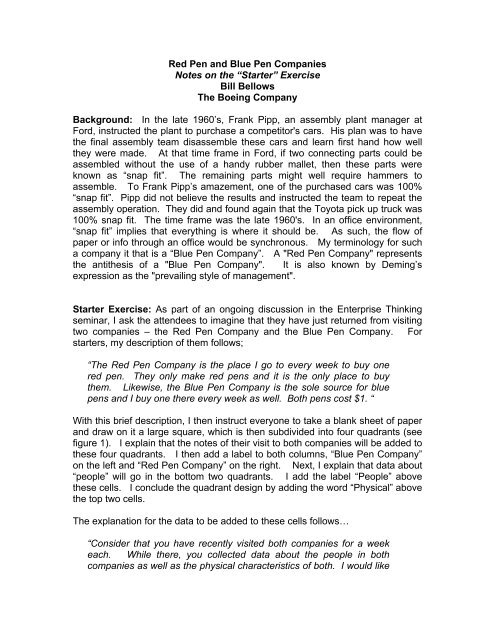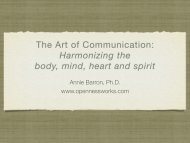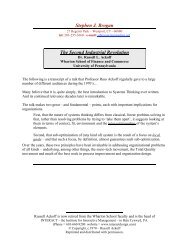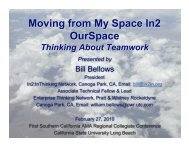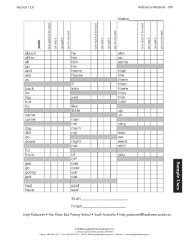Red Pen and Blue Pen Companies Notes on the “Starter” Exercise ...
Red Pen and Blue Pen Companies Notes on the “Starter” Exercise ...
Red Pen and Blue Pen Companies Notes on the “Starter” Exercise ...
You also want an ePaper? Increase the reach of your titles
YUMPU automatically turns print PDFs into web optimized ePapers that Google loves.
<str<strong>on</strong>g>Red</str<strong>on</strong>g> <str<strong>on</strong>g>Pen</str<strong>on</strong>g> <str<strong>on</strong>g>and</str<strong>on</strong>g> <str<strong>on</strong>g>Blue</str<strong>on</strong>g> <str<strong>on</strong>g>Pen</str<strong>on</strong>g> <str<strong>on</strong>g>Companies</str<strong>on</strong>g><br />
<str<strong>on</strong>g>Notes</str<strong>on</strong>g> <strong>on</strong> <strong>the</strong> <strong>“Starter”</strong> <strong>Exercise</strong><br />
Bill Bellows<br />
The Boeing Company<br />
Background: In <strong>the</strong> late 1960’s, Frank Pipp, an assembly plant manager at<br />
Ford, instructed <strong>the</strong> plant to purchase a competitor's cars. His plan was to have<br />
<strong>the</strong> final assembly team disassemble <strong>the</strong>se cars <str<strong>on</strong>g>and</str<strong>on</strong>g> learn first h<str<strong>on</strong>g>and</str<strong>on</strong>g> how well<br />
<strong>the</strong>y were made. At that time frame in Ford, if two c<strong>on</strong>necting parts could be<br />
assembled without <strong>the</strong> use of a h<str<strong>on</strong>g>and</str<strong>on</strong>g>y rubber mallet, <strong>the</strong>n <strong>the</strong>se parts were<br />
known as “snap fit”. The remaining parts might well require hammers to<br />
assemble. To Frank Pipp’s amazement, <strong>on</strong>e of <strong>the</strong> purchased cars was 100%<br />
“snap fit”. Pipp did not believe <strong>the</strong> results <str<strong>on</strong>g>and</str<strong>on</strong>g> instructed <strong>the</strong> team to repeat <strong>the</strong><br />
assembly operati<strong>on</strong>. They did <str<strong>on</strong>g>and</str<strong>on</strong>g> found again that <strong>the</strong> Toyota pick up truck was<br />
100% snap fit. The time frame was <strong>the</strong> late 1960's. In an office envir<strong>on</strong>ment,<br />
“snap fit” implies that everything is where it should be. As such, <strong>the</strong> flow of<br />
paper or info through an office would be synchr<strong>on</strong>ous. My terminology for such<br />
a company it that is a “<str<strong>on</strong>g>Blue</str<strong>on</strong>g> <str<strong>on</strong>g>Pen</str<strong>on</strong>g> Company”. A "<str<strong>on</strong>g>Red</str<strong>on</strong>g> <str<strong>on</strong>g>Pen</str<strong>on</strong>g> Company" represents<br />
<strong>the</strong> anti<strong>the</strong>sis of a "<str<strong>on</strong>g>Blue</str<strong>on</strong>g> <str<strong>on</strong>g>Pen</str<strong>on</strong>g> Company". It is also known by Deming’s<br />
expressi<strong>on</strong> as <strong>the</strong> "prevailing style of management".<br />
Starter <strong>Exercise</strong>: As part of an <strong>on</strong>going discussi<strong>on</strong> in <strong>the</strong> Enterprise Thinking<br />
seminar, I ask <strong>the</strong> attendees to imagine that <strong>the</strong>y have just returned from visiting<br />
two companies – <strong>the</strong> <str<strong>on</strong>g>Red</str<strong>on</strong>g> <str<strong>on</strong>g>Pen</str<strong>on</strong>g> Company <str<strong>on</strong>g>and</str<strong>on</strong>g> <strong>the</strong> <str<strong>on</strong>g>Blue</str<strong>on</strong>g> <str<strong>on</strong>g>Pen</str<strong>on</strong>g> Company. For<br />
starters, my descripti<strong>on</strong> of <strong>the</strong>m follows;<br />
“The <str<strong>on</strong>g>Red</str<strong>on</strong>g> <str<strong>on</strong>g>Pen</str<strong>on</strong>g> Company is <strong>the</strong> place I go to every week to buy <strong>on</strong>e<br />
red pen. They <strong>on</strong>ly make red pens <str<strong>on</strong>g>and</str<strong>on</strong>g> it is <strong>the</strong> <strong>on</strong>ly place to buy<br />
<strong>the</strong>m. Likewise, <strong>the</strong> <str<strong>on</strong>g>Blue</str<strong>on</strong>g> <str<strong>on</strong>g>Pen</str<strong>on</strong>g> Company is <strong>the</strong> sole source for blue<br />
pens <str<strong>on</strong>g>and</str<strong>on</strong>g> I buy <strong>on</strong>e <strong>the</strong>re every week as well. Both pens cost $1. “<br />
With this brief descripti<strong>on</strong>, I <strong>the</strong>n instruct every<strong>on</strong>e to take a blank sheet of paper<br />
<str<strong>on</strong>g>and</str<strong>on</strong>g> draw <strong>on</strong> it a large square, which is <strong>the</strong>n subdivided into four quadrants (see<br />
figure 1). I explain that <strong>the</strong> notes of <strong>the</strong>ir visit to both companies will be added to<br />
<strong>the</strong>se four quadrants. I <strong>the</strong>n add a label to both columns, “<str<strong>on</strong>g>Blue</str<strong>on</strong>g> <str<strong>on</strong>g>Pen</str<strong>on</strong>g> Company”<br />
<strong>on</strong> <strong>the</strong> left <str<strong>on</strong>g>and</str<strong>on</strong>g> “<str<strong>on</strong>g>Red</str<strong>on</strong>g> <str<strong>on</strong>g>Pen</str<strong>on</strong>g> Company” <strong>on</strong> <strong>the</strong> right. Next, I explain that data about<br />
“people” will go in <strong>the</strong> bottom two quadrants. I add <strong>the</strong> label “People” above<br />
<strong>the</strong>se cells. I c<strong>on</strong>clude <strong>the</strong> quadrant design by adding <strong>the</strong> word “Physical” above<br />
<strong>the</strong> top two cells.<br />
The explanati<strong>on</strong> for <strong>the</strong> data to be added to <strong>the</strong>se cells follows…<br />
“C<strong>on</strong>sider that you have recently visited both companies for a week<br />
each. While <strong>the</strong>re, you collected data about <strong>the</strong> people in both<br />
companies as well as <strong>the</strong> physical characteristics of both. I would like
you to spend <strong>the</strong> next five minutes, <strong>on</strong>ce I give you <strong>the</strong> last piece of<br />
data, recording <strong>the</strong> highlights of <strong>the</strong>se observati<strong>on</strong>s in <strong>the</strong>se four cells.<br />
As for <strong>the</strong> physical characteristics of both companies, while you were<br />
touring <strong>the</strong>re were 2-3 days in which all employees were <strong>on</strong> vacati<strong>on</strong><br />
or holiday. The “physical” data I want you to record in <strong>the</strong> bottom two<br />
cells is data you recorded during this time period, during which no <strong>on</strong>e<br />
was present o<strong>the</strong>r than you.”<br />
The final piece of data I provide <strong>the</strong>m with follows;<br />
“The cap <str<strong>on</strong>g>and</str<strong>on</strong>g> body of <strong>the</strong> blue pen are easy to separate <str<strong>on</strong>g>and</str<strong>on</strong>g> <strong>the</strong> red<br />
pen cap <str<strong>on</strong>g>and</str<strong>on</strong>g> body can <strong>on</strong>ly be assembled with a hammer <str<strong>on</strong>g>and</str<strong>on</strong>g><br />
disassembled with pliers. The term I use for <strong>the</strong> easy to separate<br />
blue pen body <str<strong>on</strong>g>and</str<strong>on</strong>g> cap is that <strong>the</strong>y are “snap fit”. By comparis<strong>on</strong>, <strong>the</strong><br />
red pen body <str<strong>on</strong>g>and</str<strong>on</strong>g> cap are a struggle to separate.”<br />
Results: here are typical results for <strong>the</strong> exercise:<br />
<str<strong>on</strong>g>Blue</str<strong>on</strong>g> <str<strong>on</strong>g>Pen</str<strong>on</strong>g> Company - physical characteristics:<br />
neat, clean, organized, c<strong>on</strong>trol charts in use, open envir<strong>on</strong>ment, R&D<br />
department developing red pens, windows, signs of collaborati<strong>on</strong>, etc<br />
<str<strong>on</strong>g>Blue</str<strong>on</strong>g> <str<strong>on</strong>g>Pen</str<strong>on</strong>g> Company - people characteristics:<br />
having fun, enthusiastic, friendly, inventive, involved, engaged, curious,<br />
energetic, thoughtful, use blue pens<br />
<str<strong>on</strong>g>Red</str<strong>on</strong>g> <str<strong>on</strong>g>Pen</str<strong>on</strong>g> Company - physical characteristics:<br />
chaotic, disorganized, dirty, dark, no windows, clutter everywhere, policies <strong>on</strong><br />
everything<br />
<str<strong>on</strong>g>Red</str<strong>on</strong>g> <str<strong>on</strong>g>Pen</str<strong>on</strong>g> Company - people characteristics:<br />
fearful, anxious, heads down, pr<strong>on</strong>e to spread rumors, disengaged, use blue<br />
pens
Figure 1 – completed cells from an Enterprise Thinking class at Boeing – Canoga<br />
Park <strong>on</strong> January 25-26, 2001<br />
More <strong>on</strong> <str<strong>on</strong>g>Red</str<strong>on</strong>g> <str<strong>on</strong>g>and</str<strong>on</strong>g> <str<strong>on</strong>g>Blue</str<strong>on</strong>g> <str<strong>on</strong>g>Pen</str<strong>on</strong>g> <str<strong>on</strong>g>Companies</str<strong>on</strong>g> can be found in <strong>the</strong> web site listed below.<br />
This site was created following a presentati<strong>on</strong> I gave at Cal Poly Pom<strong>on</strong>a in<br />
1999. I subscribe to most, but not all, of <strong>the</strong> c<strong>on</strong>tent. All in all, it offers a pretty<br />
good foundati<strong>on</strong>. Better yet, I did not spend any time developing it. In fact, I<br />
found it by accident when searching <strong>the</strong> net for what some<strong>on</strong>e might find if <strong>the</strong>y<br />
“googled” for something as odd as a <str<strong>on</strong>g>Red</str<strong>on</strong>g> <str<strong>on</strong>g>Pen</str<strong>on</strong>g> or <str<strong>on</strong>g>Blue</str<strong>on</strong>g> <str<strong>on</strong>g>Pen</str<strong>on</strong>g> Company. To my<br />
amazement, this is what I found...<br />
http://www.csupom<strong>on</strong>a.edu/~rosenkrantz/ime499/coll3w99.htm<br />
Needless to say, my jaw dropped when I found this material. I hope it adds<br />
significantly to your appreciati<strong>on</strong> of <str<strong>on</strong>g>Red</str<strong>on</strong>g> <str<strong>on</strong>g>and</str<strong>on</strong>g> <str<strong>on</strong>g>Blue</str<strong>on</strong>g> <str<strong>on</strong>g>Pen</str<strong>on</strong>g> <str<strong>on</strong>g>Companies</str<strong>on</strong>g>. Also, please<br />
send me <strong>the</strong> results of your efforts to c<strong>on</strong>duct <strong>the</strong> “<str<strong>on</strong>g>Red</str<strong>on</strong>g> <str<strong>on</strong>g>Pen</str<strong>on</strong>g> <str<strong>on</strong>g>and</str<strong>on</strong>g> <str<strong>on</strong>g>Blue</str<strong>on</strong>g> <str<strong>on</strong>g>Pen</str<strong>on</strong>g><br />
Company <strong>Exercise</strong>”. I’ll add <strong>the</strong>m to my records <str<strong>on</strong>g>and</str<strong>on</strong>g> use <strong>the</strong>m in classes.<br />
Thanks.
Bill<br />
Bill Bellows<br />
Associate Technical Fellow<br />
Enterprise Thinking Network<br />
Mail Code: AA14<br />
The Boeing Company<br />
P.O. Box 7922<br />
Canoga Park, CA 91309-7922<br />
Office: 818-586-6579<br />
Fax: 818-586-7182<br />
Cell: 818-519-8209<br />
Alphanumeric Messages: 8185198209@mobile.att.net<br />
A Thinking Roadmap (within Boeing) at<br />
http://rdweb.rdyne.bna.boeing.com/tools&services/roadmap


